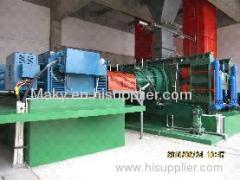
HFKG High Pressure Grinding Rolls
500000.0~900000.0 USD
| Min. Order: | 1 Set/Sets |
|---|---|
| Trade Term: | FOB |
| Payment Terms: | L/C, T/T |
| Supply Ability: | 15 sets/month |
| Place of Origin: | Shaanxi |
Company Profile
| Location: | Xi'an, Shaanxi, China (Mainland) |
|---|---|
| Business Type: | Manufacturer, Trading Company, Service |
| Main Products: | Grinder, High Pressure Grinding Rolls, Ball Mill, Mill, Mining Machine |
Product Detail
| Means of Transport: | Ocean, Land |
|---|---|
| Application: | Ore |
| Type: | Mill |
| Brand Name: | HFKG |
| colour: | bule |
| Production Capacity: | 15 sets/month |
| Delivery Date: | 120 days afer receiving the payment |
Product Description
High Pressure Grinding Rolls (HPGR) is a mature technology that is proven to reduce capital and operating costs in full scale plants when compared to other comminution technologies. Our experts have developed a simple testing methodology to avoid some of the difficulties associated with using HPGR.
HPGR has been used for many years and is emerging as an energy-efficient alternative to conventional and AG/SAG comminution circuits. One of the interesting features of HPGR is its capability to produce a particle size distribution with a greater than typical amount of fines, thus reducing the power requirement for the downstream ball mill. This makes the use of standard ball mill analyses based on the K80 inadequate, unless appropriate corrections are made. (This problem is shared by AG/SAG mill circuits.)
The most appropriate way to get around this data problem is to run the entire circuit at pilot-scale and analyze the data based on the overall power applied in kWh/t. This requires a fair quantity of sample, and the difficulties inherent to performing such a pilot plant make it difficult to come up with reliable conclusions.
The use of a small locked-cycle scale test, such as the Bond ball mill grind ability test, was proposed as an alternative way to achieve the same objective in a more controlled manner, and more importantly, with a smaller sample.
SGS has developed a simple methodology that is based on the 0.25 m LABWAL HPGR from Polysius, which has a sample top size of 12.5 mm. Several HPGR tests are performed to assess the effect of operating pressure and moisture content on the performance of the HPGR and the power input to the unit is recorded.
The HPGR product, corresponding to the best condition, is submitted to the standard Bond ball mill grindability test. The Bond ball mill grindability test measures hardness as an index, regardless of the feed size, so it does not give credit for the additional fines. Therefore, the index itself is ignored in the analysis and the results are assessed in terms of throughput rate or specific energy requirement.
The total power for the HPGR system can be compared to that of a conventional circuit, based on the rod and ball mill work indices and the Third Theory of comminution. The power comparison can also be done against AG/SAG mills. This methodology has only been used to scope the potential energy savings of HPGR at small scales.
We conduct HPGR testing in combination with other bench-scale tests and circuit simulation. The use of different test procedures and design methodologies provides you with a bankable solution that is unmatched in its rigor. Contact us to optimize the comminution design for your orebody.
HPGR has been used for many years and is emerging as an energy-efficient alternative to conventional and AG/SAG comminution circuits. One of the interesting features of HPGR is its capability to produce a particle size distribution with a greater than typical amount of fines, thus reducing the power requirement for the downstream ball mill. This makes the use of standard ball mill analyses based on the K80 inadequate, unless appropriate corrections are made. (This problem is shared by AG/SAG mill circuits.)
The most appropriate way to get around this data problem is to run the entire circuit at pilot-scale and analyze the data based on the overall power applied in kWh/t. This requires a fair quantity of sample, and the difficulties inherent to performing such a pilot plant make it difficult to come up with reliable conclusions.
The use of a small locked-cycle scale test, such as the Bond ball mill grind ability test, was proposed as an alternative way to achieve the same objective in a more controlled manner, and more importantly, with a smaller sample.
SGS has developed a simple methodology that is based on the 0.25 m LABWAL HPGR from Polysius, which has a sample top size of 12.5 mm. Several HPGR tests are performed to assess the effect of operating pressure and moisture content on the performance of the HPGR and the power input to the unit is recorded.
The HPGR product, corresponding to the best condition, is submitted to the standard Bond ball mill grindability test. The Bond ball mill grindability test measures hardness as an index, regardless of the feed size, so it does not give credit for the additional fines. Therefore, the index itself is ignored in the analysis and the results are assessed in terms of throughput rate or specific energy requirement.
The total power for the HPGR system can be compared to that of a conventional circuit, based on the rod and ball mill work indices and the Third Theory of comminution. The power comparison can also be done against AG/SAG mills. This methodology has only been used to scope the potential energy savings of HPGR at small scales.
We conduct HPGR testing in combination with other bench-scale tests and circuit simulation. The use of different test procedures and design methodologies provides you with a bankable solution that is unmatched in its rigor. Contact us to optimize the comminution design for your orebody.








